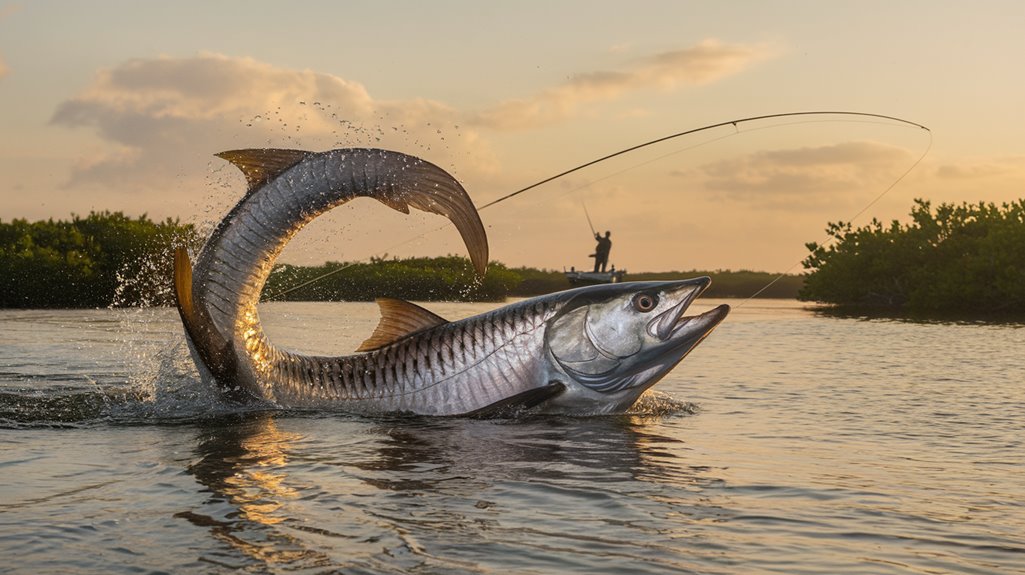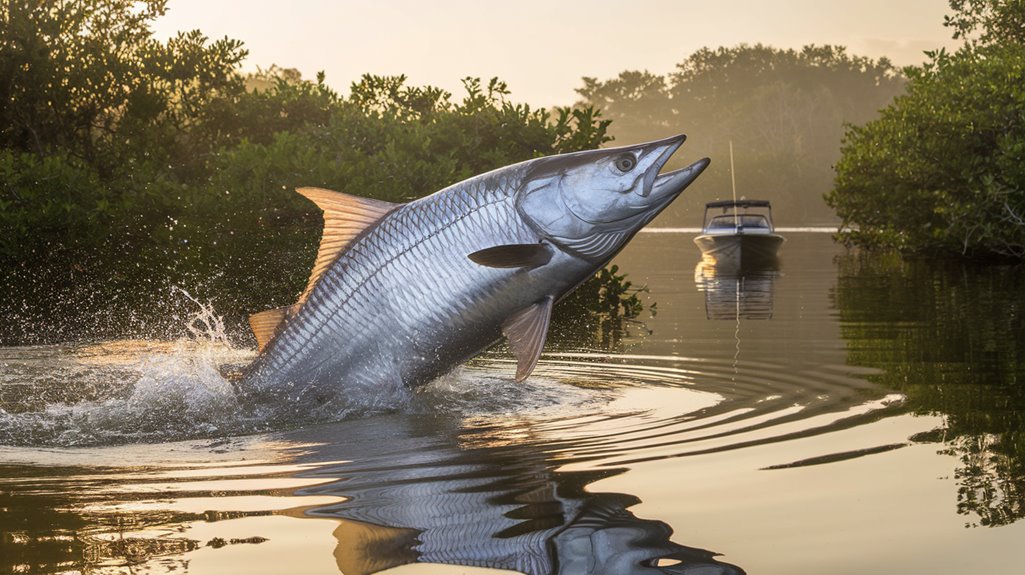You'll find tarpon migration in the Everglades offers one of North America's most technical fishing challenges. These prehistoric gamefish, weighing up to 200 pounds, follow specific patterns through the park's labyrinth of mangroves and grassflats. Understanding their movement isn't just about timing – it's about mastering the interplay between tides, water temperature, and bait patterns. Let's explore the essential elements that'll transform your next Everglades tarpon expedition from hopeful to successful.
- Key Takeaways
- Understanding Tarpon Migration Patterns in the Everglades
- Prime Fishing Seasons and Peak Activity Windows
- Essential Gear and Equipment for Tarpon Success
- Strategic Locations for Trophy Catches
- Advanced Fly Fishing Techniques and Tactics
- Weather Conditions and Environmental Factors
- Targeting Different Age Groups of Tarpon
- Navigation Tips for the Everglades Waterways
- Conservation and Responsible Fishing Practices
- Booking Your Professional Guide Experience
- Frequently Asked Questions
- Conclusion
Key Takeaways
- Tarpon migrate north through Florida Keys starting February, reaching peak activity in Everglades waters during April and May.
- Use 10-12 weight fly rods with floating lines, or 50-80 lb braided line with fluorocarbon leader for conventional tackle.
- Target southern Everglades near Flamingo, focusing on backcountry bays and river mouths where tarpon rest and feed.
- Fish during early morning or late afternoon when water temperatures exceed 75°F for optimal tarpon activity.
- Book professional guides in advance to access prime locations and receive expert guidance on specialized fishing techniques.
Understanding Tarpon Migration Patterns in the Everglades
When tarpon begin their annual spawning migration in February, they travel northward through the Florida Keys and into the Everglades by March. You'll find these magnificent fish resting and feeding in the Everglades' waters during this vital period, with specimens typically weighing between 60 to 120 pounds. It's not uncommon to encounter larger tarpon in the 150 to 180-pound range.
As April approaches, the leading edge of the migration reaches Boca Grande and Charlotte Harbor, where the numbers steadily increase. These fish will eventually move over 100 miles offshore for spawning in May and June, but they'll return within days to feed in the rivers and bays. After completing their spawning cycle, the tarpon begin their southward migration for winter.
Prime Fishing Seasons and Peak Activity Windows
As spring waters warm above 75 degrees, the Everglades' prime tarpon fishing season kicks into high gear from March through July. You'll find peak Everglades tarpon activity during April and May when large schools migrate through the region for spawning. A second robust season emerges in late summer, with October marking the final peak before departure.
- Monitor water temperatures closely – tarpon become most active above 75°F
- Plan your expeditions around the March-July primary season for best success
- Consider the late summer window (August-October) for less crowded fishing conditions
- Track weather patterns, as winter cold fronts and hurricanes can impact tarpon visibility
Understanding these seasonal windows is vital for maximizing your tarpon fishing success in the Everglades, as these magnificent fish respond predictably to environmental conditions and migration patterns.
Essential Gear and Equipment for Tarpon Success
The right gear setup can mean the difference between landing a trophy tarpon and losing the fight of a lifetime. When targeting tarpon in the Everglades, you'll need a 10-12 weight fly rod to handle these powerful fish. Any fishing guide will tell you that floating or intermediate fly lines are vital for proper presentation, while lightweight, vibrant flies like Deceivers or Clousers trigger aggressive strikes.
For conventional tackle, opt for spinning gear spooled with 50-80 lb braided line when using swimbaits or live bait. Don't skimp on your leader – an 80 lb fluorocarbon leader is essential for withstanding the abrasive mouth of a tarpon and preventing costly break-offs during intense battles. This combination of robust gear guarantees you're properly equipped for successfully landing these magnificent gamefish.
Strategic Locations for Trophy Catches
Located at the heart of tarpon migration routes, Florida's diverse coastal ecosystems offer prime locations for landing trophy-sized catches. You'll find exceptional fishing opportunities along the Southern Everglades, particularly near Flamingo, where juvenile and adult tarpon gather in abundant numbers. During peak migration months from March to July, you can target these powerful fish in waters above 75 degrees.
- Backcountry bays provide sheltered areas where migrating Tarpon rest and feed
- River mouths serve as natural funnels, concentrating fish during their seasonal movements
- Florida Bay's extensive flats and channels create perfect ambush points for trophy catches
- Boca Grande's spawning grounds attract massive schools, offering prime fishing conditions during peak season
Advanced Fly Fishing Techniques and Tactics

Successful tarpon fly fishing demands mastery of specialized techniques that build upon strategic positioning. You'll need to approach laid-up fish with stealth in clear water, making precise presentations to their feeding zones near the surface. When targeting migrating schools, position yourself to cast ahead of their path, especially during sunny conditions when visibility is ideal.
Watch for rolling tarpon and surface disturbances, then place your fly where these feeding patterns indicate activity. Select your fly patterns strategically, matching them to prevalent baitfish or crustaceans based on water conditions. The strip-set technique is vital – when a tarpon takes your fly, execute a firm strip-set to guarantee proper hook placement in their hard mouth. This specialized movement considerably improves your chances of securing these powerful gamefish.
Weather Conditions and Environmental Factors
Understanding weather patterns and environmental conditions proves critical when targeting migrating tarpon in the Everglades. You'll find these magnificent fish following the 79-degree water temperature sweet spot during their migration. Weather patterns considerably influence their movement and activity levels, with cold fronts causing them to become less visible during winter months.
- Monitor local weather forecasts to anticipate temperature changes that affect tarpon movement
- Plan your fishing trips around hurricane season to avoid dangerous conditions
- Consider mosquito activity during warmer months and prepare accordingly
- Track tidal patterns and water temperature fluctuations to optimize your chances
Your success rate will increase substantially when you factor in these environmental conditions. Local knowledge of weather patterns, combined with understanding how tarpon respond to these changes, will give you a distinct advantage in the unique ecosystem of the Everglades.
Targeting Different Age Groups of Tarpon
When targeting tarpon in the Everglades, you'll need to adjust your tactics based on the fish's age group and size class. For juvenile tarpon weighing 1-50 pounds, focus on mangrove-lined creeks and shorelines where these smaller fish congregate. You'll want to execute quick, accurate casts with fast retrieves to trigger their aggressive strikes.
Adult tarpon, often exceeding 200 pounds, require a different approach. Target these giants in deeper flats, bays, and river mouths from March through July during their migration period. On sunny days, scan for laid-up fish near the surface or look for migrating schools. Position yourself ahead of their path and present your fly accordingly. These larger specimens demand more refined techniques and patience, but they'll reward you with spectacular hook-ups when properly approached.
Navigation Tips for the Everglades Waterways
Safe passage through the Everglades' labyrinthine waterways demands meticulous planning and proper equipment. You'll need to equip your vessel with a reliable GPS or chart plotter to safely traverse the complex network of mangrove-lined creeks and shallow bays. When selecting your boat, consider a shallow-draft boat or kayak for accessing remote fishing spots where traditional vessels can't venture.
- Monitor local tide tables and current patterns to plan your route effectively
- Maintain constant awareness of water depth, especially during low tide conditions
- Study your passage charts before departure to identify unmarked obstacles
- Keep a safe distance from wildlife while moving through their habitat
Understanding these navigation tips will help you safely explore the Everglades' intricate waterways while maximizing your fishing opportunities during tarpon migration season.
Conservation and Responsible Fishing Practices
Now that you've mastered traversing the Everglades' waterways, protecting the tarpon population becomes your next responsibility. The conservation of tarpon habitats requires your commitment to responsible fishing practices. You'll need to implement catch-and-release techniques and use appropriate tackle to guarantee these magnificent fish survive and thrive.
| Practice | Method | Impact |
|---|---|---|
| Tackle Selection | Use barbless hooks | Reduces injury |
| Release Technique | Minimize handling time | Lowers stress |
| Timing | Monitor water temperature | Improves survival |
| Location | Avoid overfished areas | Maintains population |
Support local conservation programs while following regulations that protect migration routes. By using lighter lines and proper handling techniques, you'll help preserve the tarpon's complex ecosystem and guarantee future generations can experience the thrill of targeting these remarkable gamefish.
Booking Your Professional Guide Experience
To maximize your tarpon fishing success in the Everglades, booking a professional guide service like Strip Set Charters proves essential, particularly during the peak migration months of March through July. You'll want to secure your fishing trip well in advance, as prime dates fill quickly during the spring migration period.
A professional guide's expertise extends beyond mere maneuvering, offering critical insights into tarpon behavior and proven techniques for successful catches.
- Access to prime fishing locations that aren't readily available to independent anglers
- Real-time guidance on water conditions and seasonal tarpon movement patterns
- Expert instruction on specialized fishing techniques for both juvenile and trophy-sized tarpon
- Enhanced safety and compliance with local fishing regulations while traversing the Everglades' complex waterways
Frequently Asked Questions
What Month Is Best for Tarpon Fishing?
You'll find peak tarpon fishing from March through July, with April being particularly productive as they begin their Gulf Coast migration. Late summer offers a second peak in October.
What Is the Best Month to Fish in the Everglades?
You'll find ideal fishing conditions in May and June when water temperatures exceed 75 degrees. These months offer peak activity, abundant species, and perfect weather patterns throughout the Everglades ecosystem.
How Old Is a 100 Pound Tarpon?
You'll find these magnificent silver kings reaching the century mark in weight around 10-20 years of age, though their growth varies based on environmental conditions and food availability.
What Is the Best Rig for Tarpon Fishing?
You'll want a 7-9' heavy action rod with a high-capacity reel holding 300+ yards of 50-80lb braid, paired with 60-80lb fluorocarbon leader and 5/0-7/0 circle hooks.
Conclusion
Like the ancient Native Americans who traced seasonal fish patterns through the River of Grass, you'll find that mastering tarpon migration in the Everglades requires precise timing and deep ecological understanding. When you're equipped with the right 10-12 weight setup, guided expertise, and respect for conservation practices, you'll maximize your chances of connecting with these silver kings during their peak April-May migration, ensuring a sustainable legacy for future anglers.

